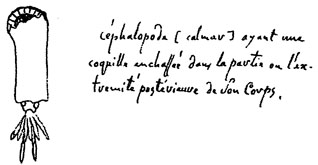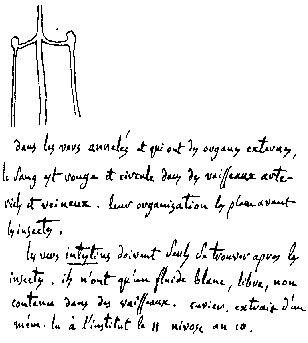The Lying Stones of Marrakech (22 page)
Read The Lying Stones of Marrakech Online
Authors: Stephen Jay Gould

Lamarck did not make copious additions, but several of his notes offer important insights, while their general tenor teaches us something important about the relative weighting of his concerns. The first forty-eight pages of the printed book contain the
Floréal
address, Lamarck's initial statement of his evolutionary theory. The final 350 pages present a systematic classification of invertebrates, including a discussion of principles and a list and description of all recognized genera, discussed phylum by phylum.
Of Lamarck's thirty-seven handwritten additions on the blank pages, twenty-nine offer only a word or two, and represent the ordinary activity of correcting small errors, inserting new information, or editing language. Lamarck makes fifteen comments about anatomy, mosdy in his chapter on the genera of mollusks, the group he knew best. A further nine comments treat taxonomie issues of naming (adding a layman's moniker to the formal Latin designation, changing the name or affiliation of a genus); two add bibliographic data; and the final three edit some awkward language.
Taken as an ensemble, I regard these comments as informative in correcting a false impression that Lamarck, by this time of seniority in his career, cared
only for general theory, and not for empirical detail. Clearly, Lamarck continued to cherish the minutiae of raw information, and to keep up with developing knowledgeâthe primary signs of an active scientific life.
Of the eight longer comments, four appear as additions to the
Floréal
address. They provide instructive insight into Lamarck's character and concerns by fulfilling the “conservative” function of making more explicit, and elaborating by hypothetical examples, the central feature of his original evolutionary theory: the sharp distinction between causes of “upward” progress and “sideward” adaptation to local circumstances.
In the two comments (among these four) that attracted most attention from potential buyers, Lamarck added examples of adaptation to local environments by inheritance of acquired characters (with both cases based on the evolutionary reorientation of eyes): first, flatfishes that live in shallow water, flatten their bodies to swim on their side, and then move both eyes to the upper surface of the head; and second, snakes that move their eyes to the top of their head because they live so close to the ground and must therefore be able to perceive a world of danger above themâand then need to develop a long and sensitive tongue to perceive trouble in front, and now invisible to the newly placed eyes. With these examples, Lamarck generalized his second set of forces by extending his stories to a variety of organisms: the
Floréal
address had confined all examples to the habits and anatomy of birds. (The purely speculative character of these cases also helps us to understand why more sober empiricists, like Darwin and Cuvier, felt so uncomfortable with Lamarck's supposed data for evolution.) In any case, Lamarck published both examples almost verbatim in his
Philosophic zoologique
of 1809.
A third comment then strengthens the other, and primary, set of linear causes by arguing that the newly discovered platypus of Australia could link the penultimate birds to the highest group of mammals. Finally, the fourth comment tries to explain the mechanisms of use and disuse by differential flow of fluids through bodies.
The other set of four longer comments adorns the second part of the book on taxonomie ordering of invertebrate animals. One insertion suggests that a small and enigmatic egg-shaped fossil should be classified within the phylum of corals and jellyfishes. A second statement, of particular interest to me, revises Lamarck's description of the clam genus
Trigonia
. This distinctive form had long been recognized as a prominent fossil in Mesozoic rocks, but no Tertiary fossils or living specimens had ever been foundâand naturalists therefore supposed that this genus had become extinct. But two French naturalists then
found a living species of
Trigonia
in Australian waters, and Lamarck himself published the first description of this triumphant rediscovery in 1803. (As an undergraduate, I did my first technical research on dissection, and also wrote my first paper in the history of science, under the direction of Norman D. Newell at the Museum of Natural History in New York. He gave me a half dozen, still preciously rare, specimens of modern Australian trigonians. When I gulped and admitted that I had no experience with dissection and feared butchering such a valuable bounty, he said to me, in his laconic mannerâso inspirational for self-motivated students, but so terrifying for the insecureâ“Go down to the Fulton Fish Market and buy a bunch of quahogs. Practice on them first.” I was far more terrified than inspired, but all's well that ends well.)

Lamarck's original illustration depicting the discovery of the squidlike animal that secretes the shell called
Spirula.
The final two comments provide the greatest visceral pleasure of all because Lamarck added drawings to his words (reproduced here with the kind permission of the book's new owner). The first sketch affirms Lamarck's continuing commitment to detail, and to following and recording new discoveries. A small, white, and delicate coiled shell of a cephalopod mollusk (the group including squid and octopuses) frequendy washes up on beaches throughout the world. Lamarck himself had named this shell
Spirula
in 1799. But the animal that makes the shell had never been found. As a particular mystery, no one knew whether the animal lived inside the shell (as in a modern chambered nautilus) or grew the shell within its body (as in the “cuttlebone” of a modern squid). The delicacy of the object suggested a protected internal status, but the question remained open. Soon after Lamarck's book appeared, naturalists discovered the animal of
Spirula
, and affirmed an internal shellâa happy resolution that inspired Lamarck to a rare episode of artistic activity.
The lastâand, as I here suggest, by far the most importantâcomment appears on the blank sheet following page 330, which contains the description of two remarkably different genera of “worms”âthe medicinal leech
Hirudo
and the pond worm
Planaria
, known to nearly anyone who ever took a basic
laboratory course in biology. Here, Lamarck draws a simple sketch of the circulatory system of an annelid worm, and then writes the following portentous words:

Lamarck's original drawing and text, expressing his first and crucial recognition that annelid worms and parasitic internal worms represent very different kinds of animals
.
observation sur l'org
on
des vers. dans les vers annelés et qui ont des organs externes, le sang est rouge et circule dans des vaisseaux arterieb et veineux. leur organisation les place avant les insectes. les vers intestins doivent seuls se trouver après les insectes. ils n'ont qu'un fluide blanc, libre, non contenue dans des vaisseaux. Cuvier. extrait d'un mém. lu a l'institut le 11 nivôse an 10
.
(Observation on the organization of worms. In annelid worms, which have external organs, the blood is red and circulates in arterial and venous vessels. Their organization places them before the insects. Only the internal worms come after the insects. They have only a white fluid, free, and not contained in vessels. Cuvier. Extract from a memoir read at the institute on the 11th day of [the month of] Nivôse year 10.)
Clearly, Lamarck now recognizes a vital distinction between two groups previously lumped together into the general category of “worms.” He regards
one groupâthe annelids, including earthworms, leeches, and the marine poly-chaetesâas highly advanced, even more so than insects. (Lamarck usually presented his scale of animal life from the top down, starting with humans and ending with infusoriansâand not from the bottom up, the system that became conventional in later zoological writing. Thus, he states that annelids come
before
insects because he views them as more advancedâthat is, closer to the mammalian top.) But another group, the internal worms
*
(mosdy parasites living within the bodies of other animals), rank far lower on the scaleâeven after (that is, anatomically simpler than) insects. These two distinct groups, previously conflated, must now be widely separated in the taxonomie ordering of life. Ironically, Lamarck acknowledges his colleague Cuvier (who would later turn against him and virtually destroy his reputation) as the source for a key item of information that changed his mindâCuvier's report (presented at a meeting during the winter of 1801â2, soon after the publication of Lamarck's book) that annelids possessed a complicated circulatory system, with red blood running in arteries and veins, whereas internal worms grew no discrete blood vessels, and only moved a white fluid through their body cavity.
Obviously, Lamarck viewed this new information as especially important, for no other anatomical note received nearly such prominence in his additions, while only one other observation (a simple new bit of information, without much theoretical meaning) merits a drawing. But why did Lamarck view this division of worms as so important? And how could such an apparendy dull and technical decision about naming act as a pivot and initiator for a new view of life?
V. A
N
O
DYSSEY OF
W
ORMS
I have always considered it odd (and redolent either of arrogance or parochiality) when a small minority divides the world into two wildly unbalanced categories of itself versus all othersâand then defines the large category as an absence of the small, as in my grandmother's taxonomy for
Homo sapiens:
Jews and non-Jews. Yet our conventional classification of animals follows the same strategy by drawing a basic distinction between vertebrates and invertebratesâ when only about forty thousand of more than a million named species belong to the relatively small lineage of vertebrates.
On the venerable principle that bad situations can always be made worse, we can gain some solace by noting the even greater imbalance devised by the founder of modern taxonomy, Carolus Linnaeus. At least we now recognize vertebrates as only part of a single phylum, while most modern schemes divide invertebrates into some twenty to thirty separate phyla. But in his
Systema naturae
of 1758, the founding document of modern zoological nomenclature, Linnaeus identified only six basic animal groups: four among vertebrates (mammals, birds, reptiles, and fishes), and two for the entire realm of invertebrates (Insecta, for insects and their relatives, and Vermes, literally worms, for nearly everything else).
When Lamarck became professor of invertebrates at the Muséum in 1793 (with an official tide in a Linnaean straitjacket as professor of insects and worms), he already recognized that reform demanded the dismemberment of Linnaeus's “wastebucket” category of Vermes, or worms.
(Wastebucket
, by the way, actually ranks as a semitechnical term among professional taxonomists, a description for inflated groups that become receptacles for heterogeneous bits and pieces that most folks would rather ignoreâas in this relegation of all “primitive” bilaterally symmetrical animals to a category of “worms” ranking far beneath the notice of specialists on vertebrates.)
In his 1801 book, Lamarck identified the hodgepodge of Linnaeus's Vermes as the biggest headache and impediment in zoology:
The celebrated Linnaeus, and almost all other naturalists up to now, have divided the entire series of invertebrate animals into only two classes: insects and worms. As a consequence, anything that could not be called an insect must belong, without exception, to the class of worms.
By the time Lamarck wrote his most famous book in 1809, his frustration had only increased, as he called Linnaeus's class of worms
“une espèce de chaos dans lequel les objets très-disparates se trouvent réunis”
(a kind of chaos where very disparate objects have been united together). He then blamed the great man himself for this sorry situation: “The authority of this scientist carried such great weight among naturalists that no one dared to change this monstrous class of worms.” (I am confident that, in writing
“cette classe monstrueuse,”
Lamarck meant to attack the physical size based on number of included genera, not the moral status, of Linnaeus's Vermes.)
